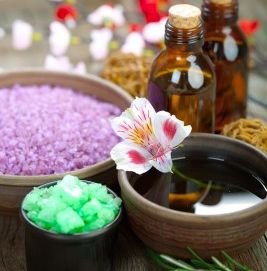An essential oil dilution chart can be helpful when blending aromatherapy products.
A typical way to dilute essential oil is in a vegetable carrier oil, such as almond, argan, coconut, grapeseed, jojoba, or olive. To dilute essential oils, drop them into a bottle or other container and then add the carrier oil. Close the container. Shake gently.
However, you can also use other carriers such as cocoa butter, shea butter, and other cosmetic butters. Typically, you need to melt the butter and stir in essential oils. Follow the instructions for the aromatherapy recipe you are making.
For most purposes, recommended dilution is 1% (for children and
sensitive individuals) to 3%. Stronger dilutions are occasionally used
for specific purposes. A common, but by no means universal, suggestion
is:
- For facial applications: 1% or less dilution
- For massages oils and other leave-on body products: 2% dilution
- For rinse-off bath and body products: 3% dilution
Generally, for essential oils that are safe for children under age 2 years, use a dilution of 0.5% or less.
You
need to know about the essential oils you are using. Some strong
essential oils have lower recommended dilutions. Best source for this information is Essential Oil Safety, 2nd Edition.
Recommendations may also be different for pregnancy or people who have a medical condition. If in doubt, consult a professional.
Essential Oil Dilution Chart
For a 1% dilution:
- 1 drop essential oil in 1 teaspoon carrier oil
- 3 drops essential oil in 1 tablespoon carrier oil
- 6 drops essential oil in 2 tablespoons carrier oil
- 24 drops essential oil in ½ cup carrier oil
If measuring carrier oil in ounces, for each ounce, use 5 to 6 drops essential oil.
If measuring carrier oil in milliliters (ml), for 30 ml, use 5 to 6 drops essential oil.
For a 2% dilution:
- 2 drops essential oil in 1 teaspoon carrier oil
- 6 drops essential oil in 1 tablespoon carrier oil
- 12 drops essential oil in 2 tablespoons carrier oil
- 48 drops essential oil in ½ cup carrier oil
If measuring carrier oil in ounces, for each ounce, use 10 to 12 drops essential oil.
If measuring carrier oil in milliliters, for 30 ml, use 10 to 12 drops essential oil.
For a 3% dilution:
- 3 drops in 1 teaspoon carrier oil
- 9 drops in 1 tablespoon carrier oil
- 18 drops in 2 tablespoons carrier oil
- 72 drops in ½ cup carrier oil
If measuring carrier oil in ounces, for each ounce, use 15 to 18 drops essential oil.
If measuring carrier oil in milliliters, for 30 ml, use 15 to 18 drops essential oil.
For a 5% dilution:
- 5 drops essential oil in 1 teaspoon carrier oil
- 15 drops essential oil in 1 tablespoon carrier oil
- 30 drops essential oil in 2 tablespoons carrier oil
- 120 drops essential oil in ½ cup carrier oil
If measuring carrier oil in ounces, for each ounce, use 26 to 30 drops essential oil.
If measuring carrier oil in milliliters, for 30 ml, use 26 to 30 drops essential oil.
For a 10% dilution:
- 10 drops in 1 teaspoon carrier oil
- 30 drops in 1 tablespoon carrier oil
- 60 drops in 2 tablespoons carrier oil
- 240 drops in ½ cup carrier oil
If measuring carrier oil in ounces, for each ounce, use 55 to 60 drops essential oil.
If measuring carrier oil in milliliters, for 30 ml, use 55 to 60 drops essential oil.
Useful Conversions
1 ounce = 2 tablespoons = about 600 drops = about 30 ml
3 teaspoons = 1 tablespoon = 15 ml = 1/2 ounce
6 teaspoons = 2 tablespoons = 1/8 cup
4 tablespoons = 1/4 cup
8 tablespoons = 1/2 cup
Drops
20 drops = 1 ml
25 drops = 1/4 teaspoon
50 drops = 1/2 teaspoon
100 drops = 1 teaspoon = 1/6 ounce = about 5 ml
300 drops = 1 tablespoon = 1/2 ounce = about 15 ml
